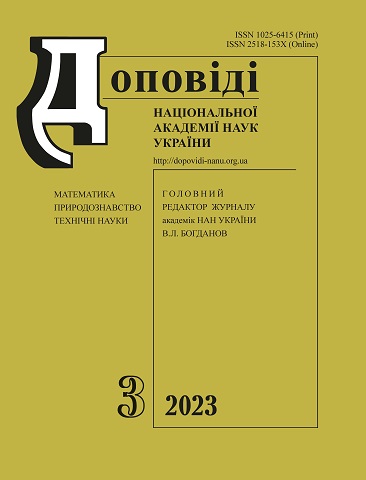Вплив катіонних поверхнево-активних антисептиків на розчинення природного поліфенолу куркуміну у водних середовищах
DOI:
https://doi.org/10.15407/dopovidi2023.03.073Ключові слова:
: куркумін, етоній, декаметоксин, солюбілізація, кето-енольна таутомерія, спектрофотометріяАнотація
Встановлено закономірності солюбілізації, таутомерних перетворень і зміни спектральних характеристик природного поліфенолу куркуміну в разі розчинення у водному середовищі катіонних ПАР — антисептиків етонію та декаметоксину залежно від їх концентрації в розчині. Показано, що в організованих міцелярних середовищах цих катіонних ПАР куркумін розчиняється в енольній формі, його розчинність збільшується на два порядки. Методом розчинності визначено величини констант зв’язування куркуміну з міцелами етонію (lgКзв = 4,39) та декаметоксину (lgКзв = 4,47). В доміцелярних розчинах довголанцюгового катіонного ПАР етонію до появи звичайних класичних міцел куркумін розчиняється у водному розчині переважно в кетонній формі і його концентрація зростає у 150 разів за рахунок утворення ним розчинних супрамолекулярних комплексів. На відміну від етонію, в доміцелярних розчинах коротколанцюгової катіонної ПАР декаметоксину практично не відбувається поліпшення розчинності та зсуву рівноваги кето-енольної таутомерії куркуміну. Виявлені закономірності мають вагоме наукове і прикладне значення для розробки лікарських препаратів на основі таких систем.
Завантаження
Посилання
Hewlings, S. & Kalman, D. (2017). Curcumin: A review of its effects on human health. Foods, 6, No. 10,
pp. 92-103. https://doi.org/10.3390/foods6100092
Mortezaee, K., Salehi, E., Mirtavoos-Мahyari, H., Motevaseli, E., Najafi, M., Farhood, B., Rosengren, R. J. & Sahebkar, A. (2019). Mechanisms of apoptosis modulation by curcumin: Implications for cancer therapy.
J. Cell. Physiol., 234, No. 8, pp. 12537-12550. https://doi.org/10.1002/jcp.28122
Vahedian-Azimi, A., Abbasifard, M., Rahimi-Bashar, F., Guest, P.C., Majeed, M., Mohammadi, A., Banach, M., Jamialahmadi, T. & Sahebkar, A. (2022). Effectiveness of curcumin on outcomes of hospitalized COVID-19 patients: A systematic review of clinical trials. Nutrients, 14, No. 2, pp. 256-268. https://doi.org/10.3390/nu14020256
Balasubramanian, K. (2006). Molecular orbital basis for yellow CURry spice CURcumin’s prevention of Alzheimer’s disease. J. Agric. Food Chem., 54, No. 10, pp. 3512-3520. https://doi.org/10.1021/jf0603533
Jamwal, R. (2018). Bioavailable curcumin formulations: A review of pharmacokinetic studies in healthy volunteers. J. Integr. Med., 16, No. 6. pp. 367-374. https://doi.org/10.1016/j.joim.2018.07.001
Zheng, B. & McClements, D. J. (2020). Formulation of more efficacious curcumin delivery systems using colloid science: Enhanced solubility, stability and bioavailability. Molecules, 25, No. 12, pp. 2791-2816.
https://doi.org/10.3390/molecules25122791
Ganguly, R., Kumar, S., Kunwar, A., Nath, S., Sarma, H. D., Tripathi, A., Verma, G., Chaudhari, D. P., Aswal, V. K. & Melo, J. S. (2020). Structural and therapeutic properties of curcumin solubilized pluronic F127 micellar solutions and hydrogels. J. Mol. Liq., 314, pp. 113591-113628. https://doi.org/10.1016/j.molliq.2020.113591
Wang, X. & Gao, Y. (2018). Effects of length and unsaturation of the alkyl chain on the hydrophobic binding of curcumin with Tween micelles. Food Chem., 246, pp. 242-248. https://doi.org/10.1016/j.foodchem.2017.11.024
Brycki, B. E., Szulc, A., Kowalczyk, I., Koziróg, A. & Sobolewska, E. (2021). Antimicrobial activity of gemini surfactants with ether group in the spacer part. Molecules, 26, No. 19, pp. 5759-5775. https://doi.org/10.3390/molecules26195759
Kovalenko, V. N. (Ed.). (2015). Compendium. Medicines. Kyiv: Morion (in Russian).
Lipkovska, N. O. & Barvinchenko, V. M. (2018). Supramolecular interactions of natural flavonoids with cationic surfactant ethonium in solutions and on silica surface. Himia, Fizika ta Tehnologia Poverhni, 9, No. 1, pp. 92-103 (in Ukrainian). https://doi.org/10.15407/hftp09.01.092
Lipkovskaya, N. A. Barvinchenko, V. N., Fedyanina, T. V. & Rugal’, A. A. (2014). Physicochemical properties of quercetin and rutin in aqueous solutions of decamethoxin antiseptic drug. Russ. J. Appl. Chem., 87, No. 1, pp. 36-41 (in Russian). https://doi.org/10.1134/S1070427214010054
Kazakova, O., Lipkovska, N. & Barvinchenko, V. (2022). Keto-enol tautomerism of curcumin in the prepara-tion of nanobiocomposites with fumed silica. Spectrochim. Acta A. Mol. Biomol. Spectrosc., 277, 121287. https://doi.org/10.1016/j.saa.2022.121287
Rosen, M. J. & Kunjappu, J. T. (2012). Surfactants and interfacial phenomena. New York: John Wiley & Sons. https://doi.org/10.1002/9781118228920
Patra, D. & Barakat, C. (2011). Synchronous fluorescence spectroscopic study of solvatochromic curcumin dye. Spectrochim. Acta A. Mol. Biomol. Spectrosc., 79, pp. 1034-1041. https://doi.org/10.1016/j.saa.2011.04.016
##submission.downloads##
Опубліковано
Як цитувати
Номер
Розділ
Ліцензія
Авторське право (c) 2023 Доповіді Національної академії наук України

Ця робота ліцензується відповідно до Creative Commons Attribution-NonCommercial 4.0 International License.




